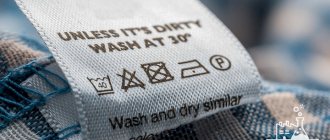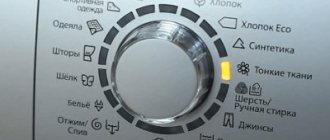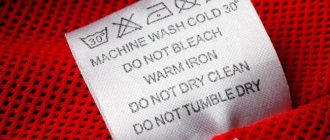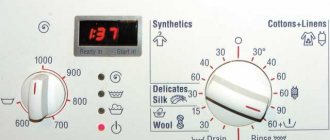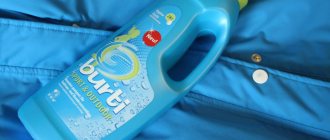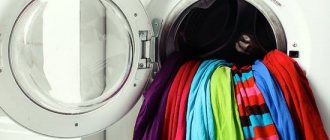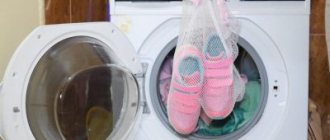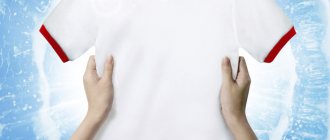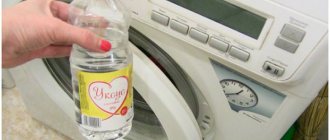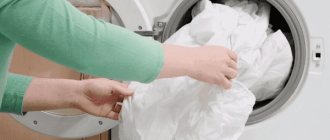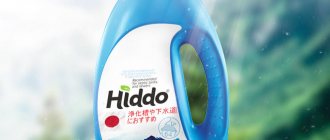Household appliances / Washing machines / How to wash
We often immediately cut off the labels that are in our way, with signs instructing us on how to properly care for the item of clothing we have purchased. Meanwhile, the information that these symbols bring to us is very important for preserving the original appearance of things. Many women are so experienced that just by one type of product and how it feels, they can determine the required washing and spinning mode, the likelihood that the fabric will fade, and at how many points this fabric needs to be ironed.
But nevertheless, you need to check the manufacturers’ recommendations, especially since recently more and more new types of fabrics have appeared, the care features of which many housewives have not yet encountered. To keep items in good condition, it is very important to be able to read the care instructions on clothing labels.
Sometimes on labels there are not signs, but inscriptions in English that do not require decoding and are understandable to everyone. They allow machine wash (Machine wash), indicate in which water - cold (Cold wash/cold rinse), warm (Warm wash/warm rinse) or hot (Hot wash) the product should be washed. Sometimes a product may give off color, in which case it requires isolation from other things (Wash separately) and hand wash (Hand wash only).
Wash
A group of symbols with the manufacturer’s recommendations for washing the fabric from which the item is made. Covers both washing methods and temperatures. Using a machine to freshen up your wardrobe items can damage some of them. Rotating the drum too vigorously can deform the material or cause the product to shrink so that you can no longer wear your beautiful wool sweater. Developers of automatic machines take into account such risks and program their equipment for different washing modes: with intense and slow rotation of the drum, with strong and weak water heating, with copious rinsing and minimal spinning.
Washing methods
| A product with such a symbol on the label can be soaked, machine washed with pre-soaking, and can also be mechanically affected in every possible way: rubbed, wrung out and twisted. The material can even withstand boiling, while its fibers will retain their original state and the color will not be lost. |
| This symbol means "gentle wash". Wardrobe items should be washed carefully and the spin speed should be medium. |
| Such a symbol requires you to wash the product delicately. If you clean it by hand, you should use plenty of water as the concentrated powder can damage the fibers of the fabric. For the same reason, you cannot rinse a thing with such a symbol for a long time, rub it or squeeze it hard. When washing in an automatic machine, you just need to select the “delicate cycle”. |
| This symbol indicates that washing such a wardrobe item is prohibited (No wash or Do not wash). You can only freshen an item by dry cleaning, since even gentle hand washing will cause the fabric to shrink and the item to lose its shape. |
| Machine washing is strictly prohibited. When the fabric is rotated in a drum, it can stretch, become damaged and lose color. Such designations are often found on the tags of outfits heavily decorated with rhinestones, sequins and other decorative elements, which can come off when washed in a machine. |
| This icon indicates that the item can only be washed by hand at a comfortable temperature of no higher than 40 degrees. Outfits with this symbol on the label should not be rubbed, squeezed or twisted too much. Hand washing is generally recommended for items made from delicate fabrics such as satin, chiffon, guipure and knitwear. |
Signs indicating the required temperature conditions
Since many fabrics may lose shape, color, or shrink greatly when exposed to excessive temperatures, it is necessary to follow the manufacturers' recommendations. Washing water that is too hot can ruin your wardrobe items and you will no longer be able to wear them.
Such signs indicate which temperature mode is best to use when washing, so as not to damage the fabric fibers, deform the product, or wash out the color from it. The lower the number, the more delicate handling the material requires.
The next group of icons slightly duplicates the previous ones, indicating the recommended water temperature. They also talk about the method of washing, spinning and acceptable detergents. Such designations are accepted in the USA, and their decoding is not difficult: the temperature of the water for treatment increases along with the number of points.
| This symbol on the tag indicates that the fabric should be washed carefully, at a temperature of 30 degrees, without rubbing or wringing. If you plan to use a washing machine, you need to set the spin intensity to minimum. |
Wash at 40, 50, 60, 75 and 95 degrees respectively.
The role of icons on clothing labels
Clothing manufacturers, taking care of consumers, indicate on the tags the rules for caring for the product. Special icons are used as a hint. They depict symbols that help you figure out how to wash things. General values:
- basin – washing mode and temperature;
- iron - ironing;
- circle – dry cleaning;
- triangle – whitening;
- square - drying.
A tag or tag is a small piece of fabric located on the wrong side of a garment. It is sewn into the side or back seam, and in shirts it is located in the collar area. Before washing, carefully read the label and determine the basic principles of care for the product. In addition to washing recommendations, the tag may contain other designations: size, type of material used, brand and country of origin.
Many people cut off the labels immediately after purchasing an item, due to the discomfort they cause. Once you cut off the label, do not throw it away. The information presented on it will be useful when the need arises to wash the product.
If the label causes inconvenience when wearing the product, cut it off, but do not throw it away. Save or take a photo of the tag - the information on it will help you choose the right way to care for the item.
Ironing
Since ironing is also a temperature effect on the fabric, manufacturers, in order to avoid damage to things at this stage of care, give recommendations on which mode to choose. Natural cotton and linen fabrics can withstand even the strongest heat, and using steam will only improve the quality of ironing. But high temperatures will only harm synthetics and wool and ruin the fabric.
| The fabric can be ironed in any mode and steamed. |
| The iron should be slightly heated to 100 degrees. This gentle mode is used for ironing non-natural fabrics - polyamide, polyacrylic, acetate, viscose. |
| The iron wheel is in the middle position (150 degrees). In this mode, wool, silk, viscose, and polyester are ironed. |
| Linen and cotton items can be ironed at the highest temperature (200 degrees). |
| The use of an iron is prohibited (No iron or Do not iron). Such markings are often found on the labels of products made from nylon or terry fabrics. |
| The product should not be ironed while wet. This applies to fabrics on which moisture will leave stains - satin, silk and satin. |
Marking: “cut cannot be saved”
How often, when we see clothes in a store window, we buy them without thinking. However, after just a few washes, the item begins to fade, stretch, and become covered in pellets. Is this a familiar picture? All you had to do was pay attention to the symbols on the tag. It’s even better to do this before purchasing the product.
Study the labels before buying - the thing you like may turn out to be extremely difficult to care for
The label on clothing is an important element. As a rule, 2 tags are sewn inside the finished item. One contains information about the composition of the fabric, the other contains instructions for caring for the product. Sometimes all the information may be on one label.
The symbols on clothing labels are international. They are established by the ISO 3758:2012 standard. Textile products. Care labeling using symbols." Throughout Russia, its analogue is in force - “GOST ISO 3758-2014. Textile products. Labeling with care symbols." The location of the marking containing information on care, fabric composition and manufacturer is regulated by GOST 10581-91 “Sewing products.
Dry cleaning
These designations will be of interest only to a dry cleaning service employee, since they indicate what special products can be used to remove stains from this type of fabric.
| Dry cleaning without using water. These instructions mainly apply to items made of wool, silk, leather and suede. |
These symbols regulate the use of various types of chemical solvents for cleaning the material.
Such icons on the tag indicate to the dry cleaning employee what the duration of treatment, humidity and temperature should be.
| This symbol indicates that dry cleaning of the product is prohibited (No Dryclear or Do not Dryclear) |
Whitening
If the product needs to be bleached, first read the instructions on the label. A prohibition on the procedure is indicated by a white or black triangle crossed out with two lines. Failure to comply with the recommendation may result in damage to the material.
An empty triangle indicates that bleaching is acceptable. The “Cl” symbol allows the use of chlorine-containing detergents. A triangle with three parallel lines - bleaching without the use of chlorine is acceptable.
Spin
Since many materials can be damaged, stretched, or, conversely, shrink significantly when pressed too intensely, you must follow the recommendations indicated on the tag.
| The material from which the item with this sign on the label is made can withstand high spin intensity and machine drying. |
| A gentle spinning and drying regime is required. |
| The product requires gentle spinning at low speeds and machine drying. |
These symbols indicate which mode to select for machine drying this product. The number of dots, like those on the iron, indicate the degree of intensity. One means gentle mode, and three allows strong and fast drying.
| Machine drying can only be done using cold air circulation. |
| Squeezing and machine drying of the product is prohibited. |
Other modes.
Cool.
The most used mode is called "cool". The Russian translation of this air conditioner mode sounds like “cold”. And it lowers the air temperature, just as the name suggests. The reason why the regime is classified as “other” is banal. He's the main one. After purchasing such a device, any person will first press two buttons: the big red one, and then the button with the snowflake icon.
Swing.
The set of modes also includes a less popular function, which allows air to be evenly distributed throughout the room thanks to the swing of the air distribution dampers (blinds). They are located in the device in front of the modules that create the air flow. If you translate “swing” (as the mode is marked on the remote control), you get “swinging”. After selecting this option, the blinds will begin to move up and down.
“Swing” has the symbol of three horizontal plates parallel to each other.
Air flow.
Another switch is associated with the “swing” option – the “air flow” button (or “air flow direction”). “Air flow” means “air flow”, and “direction” means direction. This function allows you to fix the position of the blinds, thereby directing the air flow in only one direction. To activate this function, you must first turn on the damper swing. By pressing the “swing” button, wait until the blinds are in the desired position. Then click "air flow". The air will blow in the direction the dampers point.
This option may be indicated by several wavy lines.
Timer.
Another function allows you to set a timer for turning on the air conditioner. This mode is operated using the display.
The start button is indicated by a wall clock symbol and/or the word “timer”
Auto.
Many modern systems are capable of operating in automatic temperature control mode. In this mode, the air conditioner is able to independently regulate the air temperature if it does not meet the specified parameters. You can set such parameters, or allow the machine to independently determine the comfortable temperature. One way or another, in this mode, the machine will independently make the air in the room colder or warmer if it detects excess heat or cold.
The mechanism will also prevent the room from becoming too dry or damp.
The start button usually has a large word AUTO on it.
Sleep.
Sleep is a night silent operating mode. Sleep sets the ideal room temperature for sleep and maintains it. Almost identical to automatic mode, adjusted for noiselessness. And also that Sleep is more of a safety net in case of a sudden cold snap at night.
Night mode is indicated by a month or a star.
"Turbo", "jet cool", "powerfull".
The mode, called “turbo”, “jet cool” or “powerfull”, allows you to briefly increase the power of the device until the air in the room reaches the desired state. On average, this mode does not work for more than half an hour. The mode can have different names, they usually mean “full power” or “turbo mode” in Russian. If there is a button on the remote control that is labeled with some pretentious name, most likely this is this function.
It is also designated according to the power of the designers’ imagination: a muscular arm, lightning, and the like.
Remote control functions.
The remote control may also have additional functions. These functions do not directly affect any capabilities of the air conditioner, but largely relate only to the remote control. Manufacturers often add them to their creations. As a rule, these are two main modes. Lock (close) protects the remote control from children, LED (light emitting diode) turns the remote control backlight on and off for comfortable operation at night.
Lock is indicated by an illustration indicating a lock, and the backlight is indicated by LED.
Drying
| Do not dry |
| Vertical drying - you can hang this product on a clothesline and hangers, and the fabric will not stretch or become deformed. |
| You can't wring it out, but you can hang it up. |
| Dry strictly on a horizontal surface. This instruction applies to those fabrics that can stretch and deform when dried vertically - wool, knitwear. |
| Do not dry in direct sunlight. Washed items with this sign on the tag should be placed in the shade. Similar symbols are often found on the tags of white fabrics, which can acquire an unpleasant yellow tint from exposure to the sun. Also, some bright materials are prone to fading. |
| Do not squeeze or twist (No spin). |
